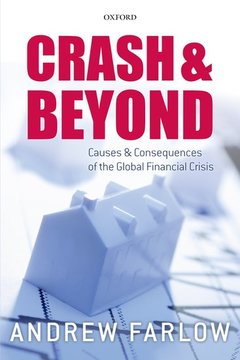Description
Crash and Beyond
Causes and Consequences of the Global Financial Crisis
Author: Farlow Andrew
Language: English
Subjects for Crash and Beyond:
Crash and Beyond
Publication date: 04-2018
440 p. · 15.4x23.3 cm · Paperback
Publication date: 04-2018
440 p. · 15.4x23.3 cm · Paperback
Crash and beyond: Causes and consequences of the global financial crisis
Publication date: 04-2013
436 p. · 16.2x24.1 cm · Hardback
Publication date: 04-2013
436 p. · 16.2x24.1 cm · Hardback
Description
/li>Contents
/li>Biography
/li>
In 2008, the world was plunged into a financial and economic crash. This book explores the roots of the crash, including the build-up of global economic imbalances, the explosion in the use of novel financial instruments, the mismanagement of risk, and the specific roles played by housing and debt. It reviews the evidence that on the eve of the crash all was not well and that many political and finance industry leaders ignored the dangers. The key events of the crash are described, and the main amplification mechanisms explained. An economics lens is used to dissect the bank rescue, paying particular attention to the hidden ways in which it worked, who will ultimately bear the costs, and to what degree new risks were created. The book evaluates the fiscal and monetary policies used to rescue economies, efforts to tackle unemployment, proposals for dealing with collapsing housing markets, austerity and the battles over long-term sovereign debt, the Eurozone crash, and the risks of future economic instability. It reviews reform-of mortgage markets, monetary policy, and banking-designed to make such disasters less likely in future. Written before, during, and in the years immediately after the crash, it is an engaging chronicle and comprehensive analysis of the events and thinking of these years. The book's arguments take on added authority given that the author had identified, and called attention to, key features of the crash before it happened.
THE ROOTS OF THE CRISIS. 1. The Growth of Global Economic Imbalances. 2. Housing and Mortgage Market Excesses. 3. Developments in the Global Financial System. 4. The Crisis Unfolds. THE RESCUE. 5. Principles of Financial Rescue and Prior Lessons. 6. An Assessment of Rescue Efforts, 2007-2010. THE FUTURE. 7. The Immediate Economic Aftermath and the Long-Term Fiscal Consequences. 8. Regulatory Reform and Long-Term Stability. 9. Lessons for Monetary and Central Bank Policy. REFLECTIONS. 10. Conclusion.
Andrew Farlow is Research Fellow in Economics at Oriel College, University of Oxford, and Senior Research Fellow at the Department of Zoology, University of Oxford. He is also a Principal Investigator of the Oxford Martin Programme on Vaccines, where he leads the Health Economics Project. After studying economics at Gonville and Caius College, University of Cambridge, and graduate economics at the University of Oxford, he now works on asset-price bubbles, banking and housing market instability, global health financing, and the economic impact of disease. He has provided advice to a wide variety of public-and private-sector organizations, including the World Health Organization, the Bill and Melinda Gates Foundation, the UK Department for International Development, the Office of Health Economics, the Areas Global TB Vaccine Foundation, the TB Alliance, and Médecins San Frontières.
© 2024 LAVOISIER S.A.S.




